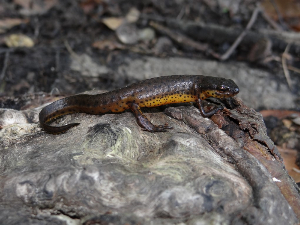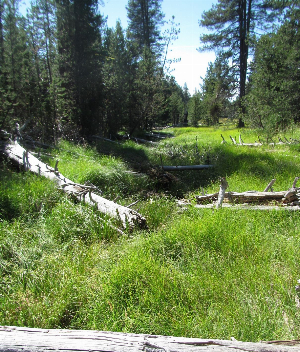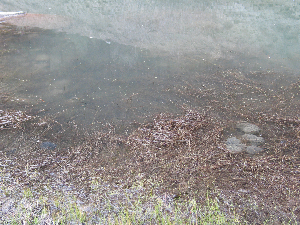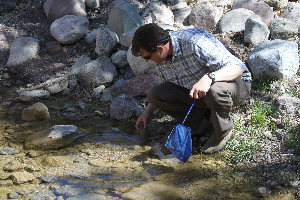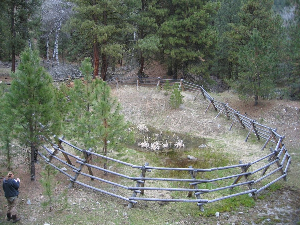Search ARMI Database
Search term(s)
Contribution Number
Search Results
74 record(s) found.
Data Release Oregon spotted frog (Rana pretiosa) telemetry and habitat use at Klamath Marsh National Wildlife Refuge in Oregon, USA
Authors: Christopher A Pearl; Jennifer C Rowe; Brome McCreary; Michael J Adams
Date: 2019-12-13 | Outlet: Science Base
We used radio-telemetry to study late-season movement and habitat use by Oregon spotted frogs (Rana pretiosa) at Klamath Marsh National Wildlife Refuge in Oregon. This data release includes frog location and habitat use data, as well as visualizations of telemetry data. Tracking events occurred roughly weekly between August and December of 2017.
Data Release Nutrients, estrogenicity, and fecal indicators in surface water collected from wetlands in the Klamath Marsh National Wildlife Refuge, Oregon, 2017-2018
Authors: Jennifer C Rowe; Kelly L Smalling; Christopher A Pearl; C E Givens; A J Sperry; Michael J Adams
Date: 2019-12-13 | Outlet: Science Base
The data was gathered to determine the effects of cattle grazing on wetland water quality in the Klamath National Wildlife Refuge in Oregon. Surface water samples from sites representing a range of grazing histories were collected between June and October in 2017 and 2018. Samples were analyzed for nutrients (ammonia, nitrate plus nitrite, nitrite and orthophosphate), total coliforms, E. coli, enterococci and estrogenicity by US Geological Survey laboratories. Basic water quality parameters such as temperature, pH, turbidity and specific conductance were also collected in the field during each site visit. Quality assurance samples (blanks and replicates) as well as method information is also included in the data release.
Data Release Telemetry and habitat data for Oregon spotted frogs (Rana pretiosa) in Oregon, USA
Authors: Christopher A Pearl; Brome McCreary; Jennifer C Rowe; Michael J Adams
Date: 2018-09-27 | Outlet: Science Base
We used radio-telemetry to study late-season movement and habitat use by the Oregon spotted frog (Rana pretiosa) at 9 sites from 4 populations along the Cascade Mountains in Oregon. This dataset includes individual frog morphometrics, location data, and habitat use during each tracking event that occurred roughly weekly between September and January of 2011, 2012, and 2016.
Papers & Reports Batrachochytrium salamandrivorans (Bsal) not detected in an intensive survey of wild North American amphibians
Authors: Hardin J Waddle; Daniel A Grear; Brittany A Mosher; G ra Campbell; Michael J Adams; Adam R Backlin; William J Barichivich; Adrianne B Brand; Gary Bucciarelli; Daniel L Calhoun; T Chestnut; J M Davenport; A Dietrich; Robert N Fisher; Brad M Glorioso; Brian J Halstead; Marc P Hayes; R K Honeycutt; Blake R Hossack; Patrick M Kleeman; J A Lemos-Espinal; Jeffrey M Lorch; Brome McCreary; Erin Muths; Christopher A Pearl; Katherine LD Richgels; C W Robinson; Mark F Roth; Jennifer C Rowe; Walt J Sadinski; Brent H Sigafus; I Stasiak; S Sweet; Susan C Walls; C J Watkins-Colwell; C Le White; L A Williams; Megan E Winzeler
Date: 2020-08-03 | Outlet: Scientific Reports 10:13012
Data Release Long-term amphibian monitoring data from the Willamette Valley, Oregon (2004-2015): U.S. Geological Survey data release
Authors: Michael J Adams; Christopher A Pearl; Brome McCreary; Stephanie K Galvan; Jennifer C Rowe; Adam Duarte; James T Peterson
Date: 2019-03-28 | Outlet: ScienceBase
This dataset contains information from surveys conducted 2004-2015 by USGS as part of a long-term amphibian monitoring effort in the Willamette Valley, Oregon. Data consist of site, survey, habitat, and species detection covariates.
Data Release Oregon spotted frog (Rana pretiosa) observations in Oregon, 2016-2024: U.S. Geological Survey data release
Authors: Michael J Adams; Christopher A Pearl; Brome McCreary; Jennifer C Rowe
Date: 2020-03-05 | Outlet: ScienceBase
This dataset contains information from surveys conducted 2016-2024 by USGS as part of an ongoing Oregon spotted frog (Rana pretiosa) monitoring effort in Oregon. USGS research activities 2016-2024 were divided into seven study design categories: breeding (egg mass counts), mid-level (visual encounter surveys for occupancy monitoring), apex (mark-recapture), telemetry, trapping, water quality (skin microbiome swabbing), and genetics (egg mass embryo or toe-clip tissue samples). Data consist of Oregon spotted frog observations aggregated by date, location, life stage, sex, and project. These data were compiled from multiple studies employing different survey methods, thus we caution users that counts are not directly comparable among projects; any counts may represent multiple detections of the same individual.
Data Release Oregon Spotted Frog (Rana pretiosa) Monitoring at Jack Creek 2015-2018 (final): U.S. Geological Survey data release
Authors: Michael J Adams; Christopher A Pearl; Brome McCreary; Stephanie K Galvan; Jennifer C Rowe
Date: 2019-02-11 | Outlet: ScienceBase
This dataset contains information from mark-recapture and egg mass surveys conducted 2015-2018 by USGS as part of an ongoing Oregon spotted frog (Rana pretiosa) monitoring effort at Jack Creek, Klamath County, Oregon. Data consist of spotted frog counts (handled by surveyors) aggregated by date, location, life stage, and sex, as well as data on environmental conditions at the time each survey. Note that due to updates in access permissions, surveyed area within each site varies over time. Thus, counts are not comparable among year, as surveyed area was not held constant.
Data Release Terrestrial salamander captures after the 2003 Clark Fire, Willamette National Forest, OR: U.S. Geological Survey data release
Authors: Nathan D Chelgren; Michael J Adams; Brome McCreary; Christopher A Pearl; Jennifer C Rowe
Date: 2019-05-21 | Outlet: ScienceBase
Data are the result of fixed-area, time-constrained searches for terrestrial salamanders within and nearby a wildfire-affected area of the Willamette National Forest, OR. The spatial extent of the study was within one kilometer of the border of the Clark fire that burned an area of 2,009 ha in 2003. Site surveys occurred during March and April, 2005. An important feature of the data is that 100m2 sub-plots (nested within plots) were repeatedly searched for terrestrial salamanders independently up to nine times so that variation in the probability of capture could be estimated and accounted for concurrent with estimates of occupancy probability.
Data Release Columbia Spotted Frog (Rana luteiventris) Breeding at Grazing Exclosures in Eastern Oregon 2002-2010 and 2013: U.S. Geological Survey data release
Authors: Michael J Adams; Christopher A Pearl; Brome McCreary; Stephanie K Galvan; Jennifer C Rowe
Date: 2018-02-01 | Outlet: ScienceBase
We studied the short-term effects of full and partial livestock grazing exclosures on Columbia Spotted Frog (CSF; Rana luteiventris) populations using a controlled manipulative field experiment with pre- and post-treatment data. This dataset includes vegetation data collected 2002-2010 and 2013 at 94 lakes and ponds in and around the Blue Mountains in eastern Oregon. Data collection followed standardized survey protocols and included annual oviposition surveys and vegetation surveys. These data allowed for quantification of CSF breeding as related to vegetation within and outside of grazing exclosures at each site.
Data Release Oregon Spotted Frog (Rana pretiosa) Monitoring in the Oregon Cascades 2012-2016: U.S. Geological Survey Data Release
Authors: Michael J Adams; Christopher A Pearl; Brome McCreary; Stephanie K Galvan; Jennifer C Rowe
Date: 2017-02-01 | Outlet: ScienceBase
This dataset contains information from visual encounter surveys conducted between 2012 and 2016 by USGS as part of an ongoing Oregon spotted frog (Rana pretiosa) monitoring effort in the Oregon Cascade Mountain Range. We surveyed 91 sites using a rotating frame design in the Klamath and Deschutes Basins, Oregon, which encompass most of the species' core extant range. Data consist of spotted frog counts aggregated by date, location, and life stage, as well as data on environmental conditions at the time of each survey.
Papers & Reports Effect of amphibian chytrid fungus (Batrachochytrium dendrobatidis) on apparent survival of frogs and toads in the western USA
Authors: Robin E Russell; Brian J Halstead; Brittany A Mosher; Erin Muths; Michael J Adams; Evan HC Grant; Robert N Fisher; Patrick M Kleeman; Adam R Backlin; Christopher A Pearl; R K Honeycutt; Blake R Hossack
Date: 2019-08 | Outlet: Biological Conservation
Despite increasing interest in determining the population-level effects of emerging infectious diseases on wildlife, estimating effects of disease on survival rates remains difficult. Even for a well-studied disease such as amphibian chytridiomycosis (caused by the fungus Batrachochytrium dendrobatidis [Bd]), there are few estimates of how survival of wild hosts is affected. We applied hierarchical models to long-term capture-mark-recapture data (mean = 10.6 yrs, range = 6?15 yrs) from >5500 uniquely-marked individuals to estimate the effect of Bd on apparent survival of four threatened or endangered ranid frog species (Rana draytonii, R. muscosa, R. pretiosa, R. sierrae) at 14 study sites in California and Oregon (USA) and one bufonid toad (Anaxyrus boreas) at two study sites in Wyoming and Montana. Our models indicated that the presence of Bd on an individual reduced apparent survival of ranid frogs by ~6?15% depending on species and sex. The estimated difference between toads with and without Bd was 19% for the Montana population and 55% for the Wyoming population; however, the 95% Credible Interval of these estimates included zero. These results provide evidence for negative effects of Bd on survival in wild populations even in the absence of obvious die-offs. Determining what factors influence the magnitude of the effects of Bd on wildlife populations is an important next step toward identifying management actions. These estimates of Bd effects are important for understanding the extent and severity of disease, whether disease effects have changed over time, and for informing management actions.
Papers & Reports Disentangling effects of invasive species and habitat while accounting for observer error in a long-term amphibian study
Authors: Jennifer C Rowe; Adam Duarte; Christopher A Pearl; Brome McCreary; Stephanie K Galvan; James T Peterson; Michael J Adams
Date: 2019-04-02 | Outlet: Ecosphere
The invasive American bullfrog (Lithobates catesbeianus) and a variety of non-native sport fish commonly co-occur in lowland lentic habitats of the western United States. Both invasive taxa are implicated in declines of native amphibians in this region, but few long-term studies of communities exist. Further, field studies of invasive-native interactions are complicated by confounding habitat modifications and observation errors. We surveyed amphibians and measured habitat characteristics for 12 years across 38 wetland sites within the Willamette Valley, Oregon, USA. We assessed the influence of invasive species, habitat, and their interactions on the distributions of five native amphibian species using a multispecies dynamic occupancy model that accounted for false-negative and false-positive detections. In general, habitat characteristics ? such as within-pond vegetation cover, surrounding forest, and drought severity ? were important for local persistence of native species when bullfrogs co-occurred. We also found evidence of a cumulative negative effect of bullfrogs and non-native fish (families Centrarchidae and Ictaluridae) on northern red-legged frog (Rana aurora) local persistence that was mediated by the dominance of invasive reed canarygrass (Phalaris arundinacea). Non-native fish and bullfrogs had variable effects on native amphibian species, but neither invasive taxa appears to be causing declines in occupied sites within our study area. Moreover, species relationships with habitat differed when invaders were present, indicating that certain habitats may increase persistence of native amphibians in the invaded landscape.
Papers & Reports Late-season movement and habitat use by Oregon Spotted Frog (Rana pretiosa in Oregon, USA
Authors: Christopher A Pearl; Brome McCreary; Jennifer C Rowe; Michael J Adams
Date: 2018-09-27 | Outlet: Copeia
Many amphibians use multiple habitats across seasons. Information on seasonal habitat use, movement between seasonal habitat types, and habitats that may be particularly valuable is important to conservation and management. We used radio-telemetry to study late- season movement and habitat use by Oregon Spotted Frog (Rana pretiosa) at 9 sites from 4 populations along the Cascade Mountains in Oregon. Movement rates declined with date and were the lowest at the end of tracking in December and January. Frogs across our sites used vegetated shallows in late summer and early fall. In fall, frogs used a range of habitat types, and at several sites moved to specialized distinctive habitats such as springs, interstices in lava rock, and semi-terrestrial beaver channels. Distance between first and last tracking location was <250 m for 84.5% (49/58) of frogs, ranged up to 1145 m, and was greater for frogs in ditch habitats than those not in ditches. DistinctiveSpecialized features like springs or semi-terrestrial retreats can host multiple frogs and may represent particularly valuable wintering habitat for R. pretiosa in some sites in their Oregon range.
Papers & Reports Regional variation in drivers of connectivity for two frog species (Rana pretiosa and R. luteiventris) from the U.S. Pacific Northwest
Authors: Jeanne M Robertson; M A Murphy; Christopher A Pearl; Michael J Adams; M I Páez-Vacas; S M Haig; David S Pilliod; A Storfer; W C Funk
Date: 2018-07-16 | Outlet: Molecular Ecology
Comparative landscape genetics has uncovered high levels of variability in which landscape factors affect connectivity among species and regions. However, the relative importance of species traits vs. environmental variation for predicting landscape patterns of connectivity is unresolved. We provide a test with a landscape genetics study of two sister taxa of frogs, the Oregon spotted frog (Rana pretiosa) and the Columbia spotted frog (R. luteiventris) in Oregon and Idaho, USA. Rana pretiosa is relatively more dependent on moisture for dispersal than R. luteiventris, so if species traits influence connectivity, we predicted that connectivity among R. pretiosa populations would be more positively associated with moisture than R. luteiventris. However, if environmental differences are important drivers of gene flow, we predicted that connectivity would be more positively related to moisture in arid regions. We tested these predictions using eight microsatellite loci and gravity models in two R. pretiosa regions and four R. luteiventris regions (n = 1,168 frogs). In R. pretiosa, but not R. luteiventris, connectivity was positively related to mean annual precipitation, supporting our first prediction. In contrast, connectivity was not more positively related to moisture in more arid regions. Various temperature metrics were important predictors for both species and in all regions, but the directionality of their effects varied. Therefore, the pattern of variation in drivers of connectivity was consistent with predictions based on species traits rather than on environmental variation.
Papers & Reports Quantifying climate sensitivity and climate driven change in North American amphibian communities
Authors: David AW Miller; Evan HC Grant; Erin Muths; Staci M Amburgey; Michael J Adams; M B Joseph; Hardin J Waddle; P TJ Johnson; Maureen E Ryan; Benedikt R Schmidt; Daniel L Calhoun; Courtney L Davis; Robert N Fisher; David E Green; Blake R Hossack; Tracy A. Rittenhouse; Susan C Walls; Larissa L Bailey; Sam S Cruickshank; Gary M Fellers; Thomas A Gorman; C A Haas; Ward Hughson; David S Pilliod; S J Price; Andrew M Ray; Walt J Sadinski; D Saenz; William J Barichivich; Adrianne B Brand; Cheryl S Brehme; Rosi G Dagit; Katy S Delaney; Brad M Glorioso; Lee B Kats; Patrick M Kleeman; Christopher A Pearl; Carlton J Rochester; Seth PD Riley; Mark F Roth; Brent H Sigafus
Date: 2018-08 | Outlet: Nature Communications
We quantified the response of amphibian communities to climatic variability across the United States and Canada using more than 500,000 observations for 81 species across 86 study areas. We estimated the relationships between annual variation in climate variables and local colonization and persistence probabilities across more than 5000 surveyed sites. This allowed us to estimate sensitivity to change in five climate variables. Climate sensitivity differs greatly among eco-regions and depends on local climate, species life-history, and phylogeny. Local species richness was especially sensitive to changes in water availability during breeding and changes in winter temperature. These results allowed us to ask whether changing climate explains strong overall rates of decline in species richness observed in our data set. We found that recent change in the climate variables we measured does not explain why North American amphibian richness is rapidly declining, but does explain why some populations decline faster than others. 
Papers & Reports Effect of cattle exclosures on Columbia Spotted Frog abundance
Authors: Michael J Adams; Christopher A Pearl; Thierry C Chambert; Brome McCreary; Stephanie K Galvan; Jennifer C Rowe
Date: 2018-02-26 | Outlet: Wetland Ecology and Management
Livestock grazing is an important land use in the western USA and can have positive or negative effects on amphibians. Columbia Spotted Frog (Rana luteiventris) often use ponds that provide water for cattle. We conducted a long-term manipulative study on US Forest Service land in northeastern Oregon to determine the effects of full and partial exclosures that limited cattle access to ponds used by frogs. We found weak evidence of a short-term increase in abundance that did not differ between full and partial exclosures and that diminished with continuing exclusion of cattle. The benefit of exclosures was small relative to the overall decline in breeding numbers that we documented. This suggests that some protection can provide a short-term boost to populations.
Papers & Reports A new parameterization for integrated population models to document amphibian reintroductions
Authors: Adam Duarte; Christopher A Pearl; Michael J Adams; James T Peterson
Date: 2017-04-28 | Outlet: Ecological Applications
Managers are increasingly implementing reintroduction programs as part of a global effort to alleviate amphibian declines. Given uncertainty in factors
affecting populations and a need to make recurring decisions to achieve objectives, adaptive management is a useful component of these efforts. A
major impediment to the estimation of demographic rates often used to parameterize and refine decision-support models is that life-stage-specific
monitoring data are frequently sparse for amphibians. We developed a new parameterization for integrated population models to match the ecology of amphibians and capitalize on relatively inexpensive monitoring data to document amphibian reintroductions. We evaluate the capability of this
model by fitting it to Oregon spotted frog (Rana pretiosa) monitoring data collected from 2007 to 2014 following their reintroduction within the Klamath Basin, Oregon, USA. The number of egg masses encountered and the estimated adult and metamorph abundances generally increased following reintroduction. We found that survival probability from egg to metamorph ranged from https://0.01 in 2008 to https://0.09 in 2009 and was not related to minimum spring temperatures, metamorph survival probability ranged from https://0.13 in 2010-2011 to https://0.86 in 2012-2013 and was positively related
to mean monthly temperatures (logit-scale slope = 2.37), adult survival probability was lower for founders (0.40) than individuals recruited after
reintroduction (0.56), and the mean number of egg masses per adult female was https://0.74. Our study represents the first to test hypotheses concerning Oregon spotted frog egg-to-metamorph and metamorph-to adult transition probabilities in the wild and document their response at multiple life stages following reintroduction. Furthermore, we provide an example to illustrate how the structure of our integrated population model serves as a useful foundation for amphibian decision-support models within adaptive management programs. The integration of multiple, but related, datasets has an advantage of being able to estimate complex ecological relationships across multiple life stages, offering a modeling framework that accommodates uncertainty, enforces parsimony, and ensures all model parameters can be confronted with monitoring data.
affecting populations and a need to make recurring decisions to achieve objectives, adaptive management is a useful component of these efforts. A
major impediment to the estimation of demographic rates often used to parameterize and refine decision-support models is that life-stage-specific
monitoring data are frequently sparse for amphibians. We developed a new parameterization for integrated population models to match the ecology of amphibians and capitalize on relatively inexpensive monitoring data to document amphibian reintroductions. We evaluate the capability of this
model by fitting it to Oregon spotted frog (Rana pretiosa) monitoring data collected from 2007 to 2014 following their reintroduction within the Klamath Basin, Oregon, USA. The number of egg masses encountered and the estimated adult and metamorph abundances generally increased following reintroduction. We found that survival probability from egg to metamorph ranged from https://0.01 in 2008 to https://0.09 in 2009 and was not related to minimum spring temperatures, metamorph survival probability ranged from https://0.13 in 2010-2011 to https://0.86 in 2012-2013 and was positively related
to mean monthly temperatures (logit-scale slope = 2.37), adult survival probability was lower for founders (0.40) than individuals recruited after
reintroduction (0.56), and the mean number of egg masses per adult female was https://0.74. Our study represents the first to test hypotheses concerning Oregon spotted frog egg-to-metamorph and metamorph-to adult transition probabilities in the wild and document their response at multiple life stages following reintroduction. Furthermore, we provide an example to illustrate how the structure of our integrated population model serves as a useful foundation for amphibian decision-support models within adaptive management programs. The integration of multiple, but related, datasets has an advantage of being able to estimate complex ecological relationships across multiple life stages, offering a modeling framework that accommodates uncertainty, enforces parsimony, and ensures all model parameters can be confronted with monitoring data.
Papers & Reports Using occupancy models to accommodate uncertainty in the interpretation of aerial photograph data: status of beaver in central Oregon, USA
Authors: Christopher A Pearl; Michael J Adams; P K Haggerty; L Urban
Date: 2015-02-27 | Outlet: Wildlife Society Bulletin 39:1944-1963
Beavers (Castor canadensis) influence habitat for many species and pose challenges in developed landscapes. They are increasingly viewed as a cost?efficient means of riparian habitat restoration and water storage. Still, information on their status is rare, particularly in western North America. We used aerial photography to evaluate changes in beaver occupancy between 1942–1968 and 2009 in upper portions of 2 large watersheds in Oregon, USA. We used multiple observers and occupancy modeling to account for bias related to photo quality, observers, and imperfect detection of beaver impoundments. Our analysis suggested a slightly higher rate of beaver occupancy in the upper Deschutes than the upper Klamath basin. We found weak evidence for beaver increases in the west and declines in eastern parts of the study area. Our study presents a method for dealing with observer variation in photo interpretation and provides the first assessment of the extent of beaver influence in 2 basins with major water?use challenges. Published 2015. This article is a U.S. Government work and is in the public domain in the USA.
Papers & Reports Short-term occupancy and abundance dynamics of the Oregon Spotted Frog (Rana pretiosa) across its core range
Authors: Michael J Adams; Christopher A Pearl; Brome McCreary; Stephanie K Galvan
Date: 2014-11-03 | Outlet: U.S. Geological Survey Open-File Report 2014-1230
The Oregon spotted frog (Rana pretiosa) occupies only a fraction of its original range and is listed as Threatened under the Endangered Species Act. We surveyed 93 sites in a rotating panel frame design (2010–13) in the Klamath and Deschutes Basins, Oregon, which encompass most of the species’ core extant range. Oregon spotted frogs are decreasing in probability of both site occupancy and abundance. We did not find an association between the probability that Oregon spotted frogs disappear from a site (local extinction) and any of the variables hypothesized to affect Oregon spotted frog occupancy. This 4-year study provides baseline data, but the 4-year period was too short to draw firm conclusions about current (2014) trends. Further study is essential to understand how habitat changes and management practices relate to the status and trends of this species.
Papers & Reports Roles of habitat, restoration, and drought frequency in driving long-term trends of a widespread amphibian
Authors: Blake R Hossack; Michael J Adams; Christopher A Pearl; K W Wilson; Evelyn L Bull; K Lohr; Debra A Patla; David S Pilliod; J M Jones; K K Wheeler; S P McKay; P. Stephen Corn
Date: 2013-12 | Outlet: Conservation Biology 27:1410-1420
Despite the high profile of amphibian declines and the increasing threat of drought and frag- mentation to aquatic ecosystems, few studies have examined long-term rates of change for a single species across a large geographic area. We analyzed growth in annual egg-mass counts of the Columbia spotted frog (<i>Rana luteiventris</i>) across the northwestern United States, an area encompassing 3 genetic clades. On the basis of data collected by multiple partners from 98 water bodies between 1991 and 2011, we used state-space and linear-regression models to measure effects of patch characteristics, frequency of summer drought, and wetland restoration on population growth. Abundance increased in the 2 clades with greatest decline history, but declined where populations are consideredmost secure. Population growthwas negatively associated with temporary hydroperiods and landscape modification (measured by the human footprint index), but was similar in modified and natural water bodies. The effect of drought was mediated by the size of the water body: populations in large water bodies maintained positive growth despite drought, whereas drought magnified declines in small water bodies. Rapid growth in restored wetlands in areas of historical population declines provided strong evidence of successful management. Our results highlight the importance of maintaining large areas of habitat and underscore the greater vulnerability of small areas of habitat to environmental stochasticity. Similar long-term growth rates inmodified and natural water bodies and rapid, positive responses to restoration suggest pond construction and other forms of management can effectively increase population growth. These tools are likely to become increasingly important to mitigate effects of increased drought expected from global climate change.
Keywords:
Keywords:

